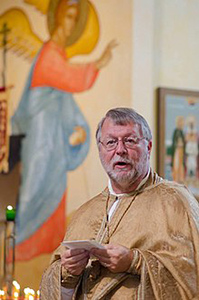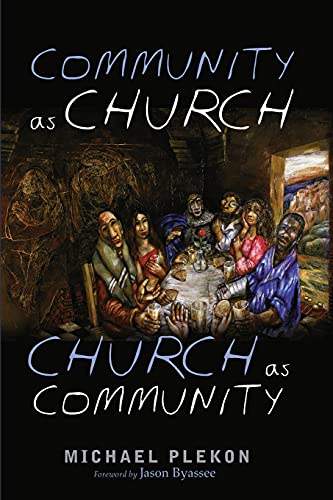November 16, 2021
Michael Plekon: Stories tell you about the struggle to keep being the church

The story of Thelma's Kitchen, on Kansas City's Troost Avenue, is among those included in "Community as Church, Church as Community" by Michael Plekon.
Church decline can’t be denied, but there is hope in the many stories of resurrection, says a sociologist and Orthodox priest.
As a sociologist, Michael Plekon has to face the facts: the situation for the church looks grim. But as a priest, he doesn’t despair.
“In the core of the Christian faith, we have the reality of Christ dying and then being raised. So if the church is the body of Christ, is the people of God, then that wonderful passage from death to life will continue,” he said.
In his book “Community as Church, Church as Community,” he lays out the challenges for the church in America. But his focus is on telling stories of resurrection — snapshots in time of congregations forging new paths and creating new ways to be the church.

From a donate-what-you-can restaurant to UMC house churches to a historic sacred space converted into a gathering place to a 24-hour coworking project, the congregations he highlights have re-imagined how they can serve God and be in community.
He did his own research and shared stories from a variety of publications to support his core point: that the church is being reinvented in communities — local parishes and congregations.
Plekon is a professor emeritus of sociology at the City University of New York-Baruch College and served as an attached priest for more than 25 years at St. Gregory Orthodox Church in Wappingers Falls, New York.
He spoke to Faith & Leadership’s Sally Hicks about the trends he sees in American society and in congregational life — and where he sees reason for hope. The following is an edited transcript.

Faith & Leadership: You share stories in the book, including some from Faith & Leadership, for which we thank you. Why is telling the stories of these congregations important?
Michael Plekon: The stories are essential. They’re not just dressing. They’re not just to make things more lively. They’re the very core of it, and that’s how God works. If we believe that God became part of creation, took on time and space and the body, well, that’s what God continues to do in congregations. They are the body of Christ.
It’s the central argument of the book that while you could describe church as many different things, the ones that are the most solid in the Scriptures are the body of the Christ and the koinonia, the community, the fellowship. And that means that there are all kinds of connections, relationships, women and men praying together, eating together and enjoying each other’s company.
I had one critic who said, “Oh, you’re just talking about happy times,” and I said, “Well, if you’ve ever lived in a community, you will know that it isn’t always happy times.”
The stories are so crucial because they tell you something about the struggle that takes place to keep being church in a particular place. Really, that’s what a congregation or a parish is.
F&L: You’re both a sociologist and a priest. From that dual vantage point, as you look at the state of congregations today, what are the big takeaways?
MP: Well, you can’t deny or try to overlook or evade the reality that congregations are declining and shrinking. There is no church body, there is no denomination that is not experiencing that. If I look at this from both perspectives, as a pastor and a sociologist, the facts are grim.
It doesn’t mean that the church is going to go away. That’s not going to happen.
[But] how long will it be possible for the model of the congregation or the parish that we’ve had for over a thousand years to keep going? Well, it will keep going in some places, but it’s already gone in other places.
What I try to do by putting in front of readers some of these cases of congregations in transition is to show that the church might get smaller but that’s not a bad thing.
Dave Barnhart down in Birmingham has a network of house churches called Saint Junia. There are all kinds of other variations on these themes that I tried to give examples of. They’re out there, and they’re changing as time goes on.
F&L: Talk a little bit about your sources of hope and the overarching theme of resurrection.
MP: I have one in mind, because I have a personal connection to it and it was just in an article that the Christian Century published. It has to do with an Orthodox parish on Troost [Avenue] in Kansas City. It was started by a priest maybe 30 or more years ago who first rented and then bought a kind of run-down commercial building. They put the church, if you will, upstairs and then put the “other church” — that is to say, space for outreach services and eventually a pay-as-you-can cafe — downstairs.
This group of clergy and laity who continue to run what is called Reconciliation Services are a huge sign of hope. If this isn’t a version of the empty tomb on Troost [Avenue] in Kansas City, then I don’t know what it is.
There are reports and there is a budget, but what you have there is a director who happens to be a priest and a board connecting continuously with the state government, with private foundations, with the federal government to keep this form of the works of love or the works of mercy going. That’s another form the church can take.
It’s kind of a best-kept secret — the church being out there in the world, being the body of Christ, feeding people, giving people a place where they can be safe, where they can interact with one another.
F&L: In your book, you say, “Pastors are often failures. … And if they cannot admit this, clergy are liars.” I know that’s a rhetorical flourish, but it does make a point.
MP: You almost cannot undertake the proclaiming of what God has to say to the rest of the world without in a certain sense becoming a failure.
It’s kind of a best-kept secret — the church being out there in the world, being the body of Christ, feeding people, giving people a place where they can be safe, where they can interact with one another.
We, because of our culture, always reward people for filling the pews or having thousands and thousands of members. But that’s really an anomaly when it comes to the average woman or man who serves in the ministry. Most of the time, they’re struggling to survive themselves.
Cathie Caimano, who is featured in my book, calls herself a free range priest and says that this is the way it was in the beginning and it’s coming back to this now.
Andy Doyle, who is an Episcopal bishop down in Texas, has written a wonderful little book called “Vocātiō: Imaging a Visible Church.” He says much the same thing: that going forward, we have to really reconsider what is the formation going to be for pastors and deacons and also how are we going to employ them or deploy them.
I think that going forward, clergy are always going to be in some ways failures, to the extent that they’re seriously ministers of the word of God and ministers to the world, ministers to the whole people of God.
So yeah, I meant to be provocative when I said that. I think that anybody who has been ordained more than a year or two would probably agree with me that if you’re going to do what’s right, you will probably provoke some kind of criticism or opposition.
F&L: Describe the experiment that you yourself tried that didn’t work out. You tried greeting parents as they dropped children off at the church. What did you learn from that?
MP: The first parish I served was a fairly large ELCA parish not too far from where I live here, maybe 400 people or more when I was there in the ’80s.
We had built a new church, but one of the things that my rector saw was that increasingly, people were dropping their kids off for Sunday school and for confirmation class, not attending themselves — even when, for example, in confirmation it was a requirement that you come to services, participating in the service, receiving communion, singing, some experience of church.
Well, what was most alarming about this is that we thought that what we were seeing was the beginning of families just deciding to opt out of church.
We tried to go out and greet between the services, not to make them feel guilty but simply to welcome them, see how things were going, because this was our only contact with them.
In some cases, people got angry with us. Why were we harassing them?
All we were doing was saying, “Hi, I hope everything is fine at home, hope the kids are having a good experience in Sunday church school.”
Now, not everybody who engaged in this kind of drop-off behavior just dropped church; some people continued to be faithful members. But in many cases, as soon as the youngest in the family was confirmed, it was goodbye church except for Christmas and Easter and, of course, weddings and funerals and baptisms and so forth.
I think one of the largest demographic factors behind this is mobility. Most of us now don’t stay where we grew up; children go away to college and university. They stay away to work, to marry, to have families, and therefore the idea of multigenerational families in a congregation, which used to be the backbone of the congregation, has simply disappeared.
Those are the kinds of things that you can’t blame on somebody’s preaching. You can’t blame things that the church, meaning the clergy and the institutional church, has done to turn people off. These are things that happen in people’s lives, and nobody can stop it.
F&L: I think you also make the point that some pastors are in impossible situations.
MP: Very much so. The very nice, neat life the congregations were able to provide for their clergy is disappearing even more quickly than the church buildings.
And for all the best reasons, sometimes people will not go along with what’s necessary to experience resurrection.
There was one congregation in Austin, Texas, where they were about ready to turn the keys in — Asbury United Methodist Church — and a new group of younger people came in, [forming] Servant Church.
They welcomed these folks who were left, who were kind of like the grandparents. Most of them stayed and took on that kind of honored role as the legacy, the history, and if you will, the grandmas and grandpas of the congregation.
The music was different from what they were used to. They turned the church on its axis and used the horizontal rather than the nave, but they still kept being church. That story has played out so many times.
So there’s hope here. It’s a very sobering picture, because for some people, this is news that somehow they’ve been able to overlook or evade — but it’s not hopeless. It’s not a matter of despair whatsoever.


Share